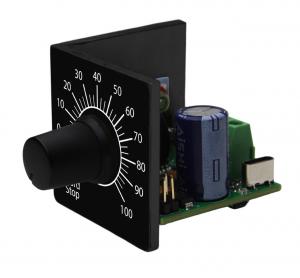Smart Motor Devices is announcing the new product – BMD-12 controller. Speed stabilization and full-fledged PID for DC motors without encoder is available now.
TALLINN, ESTONIA, October 24, 2024 /EINPresswire.com/ — Smart Motor Devices is excited to announce the release of its latest innovation, the BMD-12 DC motor speed controller. Designed to enhance the performance of DC brush motors, the BMD-12 offers advanced features such as speed stabilization, adjustable soft start and stop, and motor current limiting.
The BMD-12 controller addresses common challenges associated with DC brush motors, including short service life due to high starting currents and speed fluctuations under load. This new product offers a cost-effective solution, enabling smooth motor operation and extending motor life in a variety of industrial applications.
Innovative technology
Taking into account the market requirements, the engineers of the Smart Motor Devices company added fundamentally important functions to the new device – load compensation and engine speed stabilization, as well as a full-fledged PID controller. These two features distinguish the new device from hundreds of models available on the industrial market.
The BMD-12 utilizes speed stabilization based on the motor’s back electromotive force (EMF), which provides an optimal balance of cost and performance. This approach eliminates the need for expensive encoder-based systems, making it ideal for applications where motor positioning is not required. The controller also
BMD-12 provides:
– DC brush motor speed control without the need for an encoder;
– Load compensation for speed stabilization;
– Adjustable smooth motor start and stop;
– Full PID controller for fine-tuning performance with various motor and load configurations.
Why the load compensation and speed stabilization in BMD-12 are based on motor back EMF?
The controllers BMD-12 implement rotation speed stabilization based on the back EMF of the motor, since this method is optimal both in terms of the cost of the final system and in terms of the motor performance.
It is known that the rotation speed of a DC brush motor depends on the load torque. To stabilize the speed when the load changes, an external controller and a feedback system are required to detect the change, correct the control action and stabilize the rotation speed.
There are several feedback options that can be used to solve the speed stabilization task: current feedback, external encoder feedback, and motor back EMF feedback.
1. Why not encoder?
Data from an encoder (resolver, tachogenerator) is often used as a feedback source. However, this approach, while eliminating one problem – speed fluctuations when changing the load, adds another – complicating and increasing cost of the system.
2. Why not current feedback?
Due to its ease of implementation and low cost, сurrent feedback is often used in budget systems where output speed must be approximately maintained, but there are no strict requirements for the actual speed and drive response time to load changes. Typical examples of devices based on load compensation RxI controllers are household sewing machines, home power tools (drills, screwdrivers), kitchen appliances (mixers, meat grinders, etc.). Due to the control principle, speed stabilization is carried out with a delay, jerks and twitches are inevitable when the load changes. Another significant drawback of such devices is the need for manual adjustment of each device with a specific motor. During the adjustment, not only speed adjustment is required, but also imitation of the motor load. In this case, the compensation level is selected empirically based on the test load results. If during operation the speed or load differs significantly from the test ones, the quality of speed stabilization will be worse.
3. Why it is a motor BEMF?
Speed stabilization based on the motor’s back EMF is the best option for industrial systems using a motor without an encoder. On the one hand, the system is budget-friendly (unlike encoder based devices), since it can be used with a motor without an encoder. On the other hand, there is no need for initial setup, as in the case of current feedback. When stabilizing speed based on BEMF, the controller monitors the motor speed, the correction is faster, and when the load changes, there are no jerks or self-oscillations, typical for devices with current feedback (load compensation RxI based devices).
4. Why BMD-12 has got a full PID regulator?
The built-in PID controller allows users to adjust the system’s proportional, integral, and differential coefficients, ensuring precise control over motor speed and smooth operation under varying load conditions. This feature makes the BMD-12 suitable for tasks demanding high accuracy and responsiveness.
Applications
The BMD-12 is designed for industrial systems where maintaining a stable motor speed is critical but does not require an encoder. Its affordability, flexibility, and ease of use make it a perfect fit for controlling various motor types, ensuring reliable and efficient operation in applications such as manufacturing equipment, conveyors, and other automated systems.
“We developed the BMD-12 to address the specific needs of our customers who require precise motor control without the complexity and cost of encoder-based systems,” said a representative from Smart Motor Devices. “With this controller, we are offering a robust, easy-to-use solution that delivers consistent performance.”
For more information about the BMD-12 DC motor speed controller, visit Smart Motor Devices Website.
Sergei Sergeev
SMART MOTOR DEVICES OÜ
655 9914
email us here
Legal Disclaimer:
EIN Presswire provides this news content “as is” without warranty of any kind. We do not accept any responsibility or liability
for the accuracy, content, images, videos, licenses, completeness, legality, or reliability of the information contained in this
article. If you have any complaints or copyright issues related to this article, kindly contact the author above.
![]()






